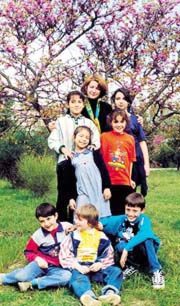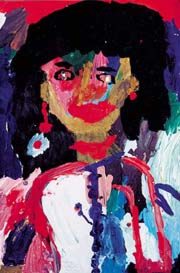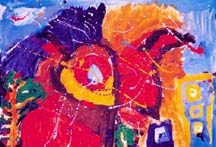|

Summer
1999 (7.2)
Pages
86-87
Unlocking
Children's Creativity
by Inna
Kostina
 Visit
AZgallery.org for more works of Inna Kostina Visit
AZgallery.org for more works of Inna Kostina
What's the secret
behind unlocking a child's creativity in the Arts? What's the
best way to work with children? How can you get them to express
themselves creatively? Actually, in my own experience, I've found
the answer is quite simple because children are not afraid of
feeling, loving or expressing their feelings. I am absolutely
convinced that all children have God-given talents. They are
all good at sculpting, dancing, drawing and singing up until
the time that adults burden them with complexes (often their
very own) by criticizing them.
I never make a distinction between intelligent and unintelligent
children-every child can create. Every child can vividly perceive
the world around them and learn to express their feelings about
it.
When adults pressure and criticize them, however, these talents
become suppressed. By the time children become adults, these
creative qualities have been replaced by workmanship, which is
not the same thing as creativity. The few individuals who manage
to keep the child inside them alive are the real geniuses.
Inna Kostina with students. First row (l-r): Teymur Mammadov,
Igor Pokatilov and Kamran Hasanov. Standing: (clockwise from
back) Teacher Inna Kostina, Natavan Aliyeva, Natavan Malikova,
Leyla Aliyeva and Gunel Malikova.
Role of the
Teacher
  What exactly is the
role of the teacher of art? I think children need teachers who
will see each little child as a distinct personality and a creator
and who will help them believe in their own abilities and power.
The relationship between a child and a teacher must be built
on affection and mutual confidence. What exactly is the
role of the teacher of art? I think children need teachers who
will see each little child as a distinct personality and a creator
and who will help them believe in their own abilities and power.
The relationship between a child and a teacher must be built
on affection and mutual confidence.
Myself, I don't teach children to draw in the sense of "school."
My aim is to unleash the potential creative ability that already
exists in every child from birth. I help them understand their
feelings and express their personality in color in various media.
I also teach them to open their eyes and see the beauty that
surrounds their everyday lives.
Natavan Malikova, 6, "Portrait of Inna, my Teacher".
Art Classes
I like
to organize classes for three to five children, ages 5 to 12.
We begin each three-hour lesson with a discussion about art history-this
provides a theoretical basis for our work. Based on the theme
of the day, we review sketchbooks and slides and learn about
various techniques. We do our work, not on a table or desks,
but on a carpet, so the children are free to sit, lie down or
crawl around as they wish.
 Next,
we move to the practical section. During this time, the kids
express their feelings and practice what they've learned. If
they choose to paint, I provide them with gouache paint and large
sheets of paper. (This type of water-soluble paint can be removed
if they decide to make a change.) They can also draw with colored
chalk or pastels, make a collage, or make sculptures using a
material like modeling clay. We sometimes even use bread. Any
material can be used to express the feelings they have. And every
lesson turns into a big holiday for all of us. We always take
a break and have a little tea party, giving the children a chance
to talk about anything they wish. Next,
we move to the practical section. During this time, the kids
express their feelings and practice what they've learned. If
they choose to paint, I provide them with gouache paint and large
sheets of paper. (This type of water-soluble paint can be removed
if they decide to make a change.) They can also draw with colored
chalk or pastels, make a collage, or make sculptures using a
material like modeling clay. We sometimes even use bread. Any
material can be used to express the feelings they have. And every
lesson turns into a big holiday for all of us. We always take
a break and have a little tea party, giving the children a chance
to talk about anything they wish.
Leyla Aliyeva, 4, "Still Life With Candles", 60
x 42 cm, gouache on paper, 1997.
 Finally,
we analyze and talk about each child's work so that they can
learn from one another. All kinds of themes emerge in their artwork,
including the circus, Noruz [Spring Solstice which traditionally
marks the New Year], their families and friends, the Caspian
sea, seasons, Christmas, butterflies and outer space. Finally,
we analyze and talk about each child's work so that they can
learn from one another. All kinds of themes emerge in their artwork,
including the circus, Noruz [Spring Solstice which traditionally
marks the New Year], their families and friends, the Caspian
sea, seasons, Christmas, butterflies and outer space.
Then there's Pushkin's Fairy Tales, Biblical stories like "Adam
and Eve" and Greek myths such as the "Flight of Icarus".
Gunel Malikova, 7, "Little Red Riding Hood", 60
x 90 cm, gouache, 1997.
There's one other crucial element in the formula for successfully
unlocking creativity in children-that is the home. Children need
support from their families. Children take their cues from adults
and become confident and positive about  their creative work if it is their creative work if it is
appreciated at home. The success of our children is dependent
upon the interaction of these three main elements: Teacher-Child-Family.
Since I've started teaching children these past few years, it's
curious how they have influenced my own professional artwork.
They've taught me to look at the world in a different, more optimistic
way. My own art has become warmer, brighter and fresher-thanks
to them. It doesn't matter that they are five or six or seven
years old. They, in fact, have much to offer and teach us adults
as well.
Teymur Mammad, 7, "Horseman", 1997.
Inna Kostina is a professional artist herself in addition
to cultivating the arts in children. Her students will be displaying
their works in the group's second exhibition entitled "Seven
Bright Butterflies" on June 2, 1999 in the Artists' Union
on Khagani Street near the Turkish Embassy. More than 60 works
will be on display. Each of these young people has participated
in both national and international competitions. The works of
Inna Kostina and her students will be exhibited on the AZ Art
Gallery on the Internet organized by Azerbaijan International
magazine. Visit www.azer.com beginning in mid-summer 1999. For
more information about the exhibition, Mrs. Kostina can be reached
at Hajibeyli Street 66/43 in Baku. Tel: (99-412) 62-77-98 (home)
or 60-02-66 (studio).
From Azerbaijan
International
(7.2) Summer1999.
© Azerbaijan International 1999. All rights reserved.
Back to Index
AI 7.2 (Summer 99)
AI Home
| Magazine
Choice | Topics
| Store
| Contact
us
|